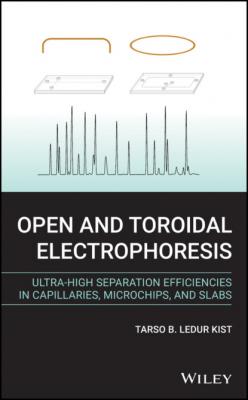Open and Toroidal Electrophoresis. Tarso B. Ledur Kist
Читать онлайн.| Название | Open and Toroidal Electrophoresis |
|---|---|
| Автор произведения | Tarso B. Ledur Kist |
| Жанр | Химия |
| Серия | |
| Издательство | Химия |
| Год выпуска | 0 |
| isbn | 9781119539247 |
Table of Contents
1 Cover
2 Preface
3 Acronyms
6 1 Solvents and Buffer Solutions 1.1 Water as a Solvent 1.2 Binary Mixtures and Other Solvents References
7 2 Fundamentals of Electrophoresis 2.1 Introduction 2.2 The Platforms 2.3 Electrophoresis 2.4 Electrophoresis of Single Molecules 2.5 Ionic Limiting Mobility 2.6 Bands, Fronts, Peaks, and Zones 2.7 The Isoelectric Point 2.8 Turbulent and Laminar Flow 2.9 Electroosmosis 2.10 Supression of EOF 2.11 Joule Effect and Heat Dissipation 2.12 Temperature Profiles 2.13 Molecular Diffusion and Band Broadening 2.14 Sample Stacking and Band Compression 2.15 Separation Modes References
8 3 Open Layout 3.1 Introduction 3.2 Capillary Electrophoresis 3.3 Microchip Electrophoresis 3.4 Slab Electrophoresis 3.5 Performance Indicators for Open Layouts References
9 4 Toroidal Layout 4.1 Introduction 4.2 Toroidal Capillary Electrophoresis 4.3 Toroidal Microchip Electrophoresis 4.4 Toroidal Slab Electrophoresis 4.5 Folding Geometries 4.6 Microholes and Connections 4.7 Reservoirs 4.8 Active and Passive Modes of Operation 4.9 Performance Indicators for Toroidal Layouts References
10 5 Confronting Performance Indicators 5.1 Introduction 5.2 Performance Indicators from Experimental Data 5.3 Performance Indicators Predicted from Operational Parameters References
11 6 High Voltage Modules and Distributors 6.1 Introduction 6.2 High Voltages in Open Layouts 6.3 High Voltages in Toroidal Layouts References
12 7 Heat Removal and Temperature Control 7.1 Introduction 7.2 Temperature Gradients are Unavoidable 7.3 Temperature has Multiple Effects 7.4 Electrical Insulators with High Thermal Conductivity 7.5 Cooling Strategies Used in Capillary Electrophoresis 7.6 Cooling Strategies Used in Microchip Electrophoresis 7.7 Cooling Strategies Used in Slab Electrophoresis 7.8 Shear Rate of the Coolant 7.9 Final Considerations References Note
13 8 Detectors 8.1 Introduction 8.2 Fixed Point Detectors 8.3 Spatial Detectors (Scanners and Cameras) 8.4 Derivatization Reactions References
14 9 Applications of Toroidal Electrophoresis 9.1 Introduction References
